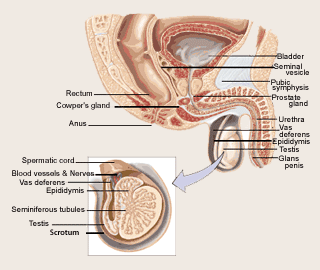Pure Seminoma Stage III
 Pure Seminoma Overview
Pure Seminoma Overview
Patients with Stage III seminoma have spread of cancer outside the testes and retroperitoneal lymph nodes and are curable in more than 90% of cases.
The following is a general overview of treatment for Stage III seminoma. Cancer treatment may consist of surgery, radiation, chemotherapy, targeted therapy, or a combination of these treatment techniques. Combining two or more of these treatment techniques--called multi-modality care--has become an important approach for increasing a patient's chance of cure and prolonging survival.
In some cases, participation in a clinical trial utilizing new, innovative therapies may provide the most promising treatment. Treatments that may be available through clinical trials are discussed in the section titled Strategies to Improve Treatment.
Circumstances unique to each patient's situation influence which treatment or treatments are utilized. The potential benefits of multi-modality care, participation in a clinical trial, or standard treatment must be carefully balanced with the potential risks. The information on this Web site is intended to help educate patients about their treatment options and to facilitate a mutual or shared decision-making process with their treating cancer physician.
Since patients with Stage III testicular seminoma have widespread cancer, the treatment of choice is systemic chemotherapy. The most frequently utilized chemotherapy combinations include bleomycin, etoposide and Platinol® (cisplatin) (BEP) for 3 courses or etoposide and Platinol (EP) for 4 courses in good-prognosis patients.[1] The cure rate following either of these regimens is approximately 90%.
After completion of therapy, a residual mass in the location of the original cancer is often detected by computed tomography (CT), magnetic resonance imaging (MRI), or positron emission tomography (PET) scans. A residual mass may represent scar formation or inadequately treated cancer, and is best evaluated by PET scan at least 6 weeks after completing chemotherapy. If the PET scan is negative, routine follow up is indicated. If the PET scan is positive, there may be residual cancer and a biopsy is considered useful in order to determine the most appropriate course of action.[1]
Strategies to Improve Treatment
The progress that has been made in the treatment of testicular cancer has resulted from improved development of chemotherapy and radiation treatments in patients with more advanced stages of cancer and participation in clinical trials. Future progress in the treatment of testicular cancer will result from continued participation in appropriate clinical trials.
Supportive Care: Supportive care refers to treatments designed to prevent and control the side effects of cancer and its treatment. Side effects not only cause patients discomfort, but also may prevent the optimal delivery of therapy at its planned dose and schedule. In order to achieve optimal outcomes from treatment and improve quality of life, it is imperative that side effects resulting from cancer and its treatment are appropriately managed. For more information, go to Managing Side Effects.
New Adjuvant Chemotherapy Regimens: The goal of developing new chemotherapy regimens is to decrease short- and long-term side effects without compromising the chance of cure. Several new chemotherapy drugs show promising activity for the treatment of testicular cancer. The combination of cyclophosphamide and Paraplatin® (carboplatin) chemotherapy appears to be as effective as Platinol, etoposide, and bleomycin combinations without the severity of side effects.[2]
References:
--------------------------------------------------------------------------------
[1] National Comprehensive Cancer Network. NCCN Clinical Practice Guidelines in Oncology.™ Testicular Cancer. V.2.2008. © National Comprehensive Cancer Network, Inc. 2008. NCCN and NATIONAL COMPREHENSIVE CANCER NETWORK are registered trademarks of National Comprehensive Cancer Network, Inc.
[2] Amato RJ, Millikan R, Daliani D, Wood L, Logothetis C, Pollack A. Cyclophosphamide and carboplatin and selective consolidation in advanced seminoma. Clinical Cancer Research. 2000;6:72-7.
Pure Seminoma - Stages & Types of Treatment |
|
